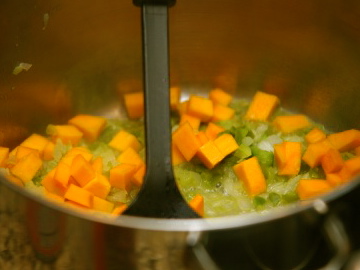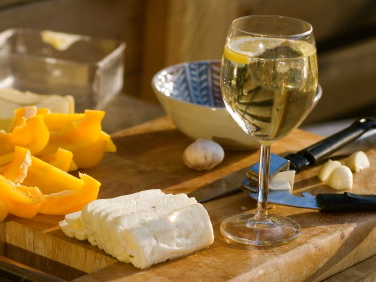
reference-image, l
(article, Kelly Myers)
[%pageBreakSettings nobreak=true] Last summer I read a New York Times article titled "Mom Puts Family on Her Meal Plan." I still marvel that the writer, Leslie Kaufman, manages to feed home-cooked meals to her family of four on most nights — even though Kaufman works outside the home and is the only adult in her household who cooks. Kaufman’s regimen goes like this: On Sunday, shop for and cook dinners that can be made or at least set up ahead of time. (Kaufman favors meatballs, soup, roast chicken, and pot roast.) That covers Sunday, Monday, and Tuesday. For Wednesday, whip out a regular recipe you can throw together in a flash. (One of Kaufman’s, for example, is pasta dressed with goat cheese and sautéed vegetables.) On Thursday, eat takeout. On Friday, reheat leftovers. And on Saturdays, go out. [%image feature-image float=left width=350 credit="Photo: iStockphoto/Multiart" caption="Get your prep work out of the way and enjoy that glass of wine."] Granted, Kaufman is assuming you can afford to order takeout or go out to eat twice a week. Even so, planning ahead three or four home-cooked meals every week takes work. When it comes to dinnertime, there are really only three options on the menu: eat out or get takeout; make do with the assorted contents of your cupboards and refrigerator; or write a list, shop, and cook. The last option is more work up front, but it reduces your chances of picking up the phone to call for pizza or pouring out a bowl of cold cereal twice in one day. I find that if I can make two dishes or dinners on a Sunday afternoon, I'm nearly set for civilized workweek dinners. Even if I only come up with a soup, I've made a step toward balanced eating. A soup can fill the role of main dish (minestrone or ribollita) or a vegetable (a winter squash purée with rapini), or a grain (mushroom barley). My physician sister counsels that for weight loss, it’s good to serve soup with dinner because it's typically low-fat and filling. [%image reference-image float=right width=350 credit="Photo: iStockphoto/DIGIcal" caption="A mirepoix of sautéed carrots, celery, and onions is the versatile basis of many dishes."] Some are less meat-centric in their cook-ahead sessions than Kaufman. My friend Bill has a teenaged daughter who's vegetarian, so on Sunday afternoons, Bill will put on a pot of beans and maybe bake a loaf of bread. The rest of the week, he serves enchiladas, tacos, and tortas. He keeps cornmeal in the refrigerator because cornbread comes together quickly. At this time of year, winter squash and kale are the staple vegetables at his house. The point is to find a routine and ingredients that fit you. With my sister, it usually starts with an impulse to bake. Recently she made pita for the first time. They didn’t all form pockets as she'd hoped, but the fresh-off-the-griddle flatbreads made excellent wraps for leftover roast pork with coleslaw. The recipe for whole-wheat pita my sister found claimed the refrigerated dough would keep its oomph for days. If that's true, I bet she'll concoct future pita-based meals. The coleslaw my brother-in-law of Polish extraction loves so much could accompany many fillings. In this case, my sister put her investment not in a roast or stew, but merely a batch of dough. Nirvana is a set of menus you can pull off smoothly no matter what else happens in your life. Until that elevated state is reached, find a measure of peace by adopting the following work habits that professional prep cooks rely on for efficient cooking: # Clear the decks. Tidy up and clear off all work surfaces. All cookware or tools you’ll need should be clean and easy to find. # If you're using a recipe, read it through at least once before starting. Find out before you start dicing and browning that your osso buco requires carrot juice. Put your recipe somewhere easy to read and out of the way. I hang mine from a magnetic clip on the refrigerator. # Mentally sketch out your work session. This is especially important if you have more than one cooking project. Your thinking might go like this: “I’m going to put a chicken in the oven to roast for dinner tonight. While it’s in the oven, I’ll start a bean soup. Both the chicken and soup will provide leftovers for the week. While the chicken roasts and the soup simmers, I’ll wash spinach, slice veggies, and make dressing for a salad, and I’ll make sure to do extra to have ready for future salads this week.” # Set up your mise en place. Mise en place means not having to interrupt your cooking to find a tool or prep an ingredient, because you have it all set up. Your oven is preheated. Your chef’s knife is sharp. Your parsley is washed, dried, and chopped. Your ginger is grated. Your prepared ingredients are all set out in bowls. Your liquids are measured. # When chopping, have the item to be chopped on your left. As you chop it, push it off to the right out of your way. (Or switch it up, if you're a southpaw.) When your cutting board gets too full, put the chopped ingredients in a bowl until you need them. # As you start to move through your list, stop periodically to check in with yourself. You may need to make adaptations. For example, “I think I’ll roast root vegetables along with the chicken. That way, I’ll have them to go with the leftover chicken for a quick ragú over pasta or polenta.” # Clean up as you work. Keep a sink full of soapy water for prep dishes, or at least rinse and stack. Keep work surfaces and your cutting board clear. [[block(sidebar). h1. Featured recipes]] Finally, find other ways besides weekend cooking to reduce or break up the work of making dinner. Become your own stealth prep cook. Use early mornings or evenings after dinner for small tasks. While the coffee brews, measure out dry ingredients for cornbread that night. Cut up bacon or pancetta for pasta carbonara. Wash and prep broccoli for steaming. When you’ve finished, give yourself a pat on the back (or a glass of wine) for being so on top of things. Actual cooking, the applying of heat to food, is not so time-consuming. It’s the shopping and peeling, mincing, and washing that takes the most time. And the eating? Gone in nothing flat. p(bio). Kelly Myers is a chef and writer in Portland, Oregon. Also on Culinate: Carrie Floyd writes about cooking large quantities for the freezer.

reference-image, l

feature-image, l

promo-image, l